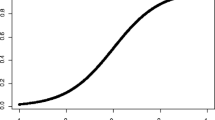Abstract
This paper presents a Bayesian model based clustering approach for dichotomous item responses that deals with issues often encountered in model based clustering like missing data, large data sets and within cluster dependencies. The approach proposed will be illustrated using an example concerning Brand Strategy Research.
Similar content being viewed by others
References
AGRESTI, A. (2002), Categorical Data Analysis, New York: John Wiley.
BANFIELD, J.D., and RAFTERY, A.E. (1993), “Model-based Gaussian and Non-Gaussian Clustering”, Biometrics 49, 803–821.
BENSMAIL, H., CELEUX, G., RAFTERY, A.E., and ROBERT, C.P. (1997), “Inference in Model Based Clustering”, Statistics and Computing 7, 1–10.
BRETHOUWER, W., LAMME, A., RODENBURG, J., DU CHATINIER, H., and SMIT, M. (1995), Quality Planning toegepast (Dutch), Amsterdam: Janssen Offset.
CALLEBAUT, J., JANSSENS, M., OP DE BEECK, D., LORRÉ, D., and HENDRICKX, H. (1999), Motivational Marketing Research Revisited, Leuven: Garant Publishers.
COWLES, M.K., and CARLIN, B.P. (1996), “Markov Chain Monte Carlo Convergence Diagnostics: A Comparative Review”, Journal of the American Statistical Association 91, 833–904.
DEMPSTER,A.P., LAIRD,N.M., and RUBIN,D.B. (1977), “Maximum Likelihood from Incomplete Data via the EM algorithm”, Journal of the Royal Statistical Society, Series B 39, 1–38.
EVERITT, B.S. (1988), “AMonte Carlo Investigation of the Likelihood Ratio Test for Number of Classes in Latent Class Analysis”, Multivariate Behavioral Research 23, 531–538.
FRALEY, C., and RAFTERY,A.E. (1998), “HowMany Clusters? Which ClusteringMethod? Answers via Model-Based Cluster Analysis”, Technical Report No. 329, Department of Statistics, University of Washington.
GELMAN, A., MENG, X., and STERN, H.S. (1996), “Posterior Predictive Assessment of Model Fitness via Realized Discrepancies (With Discussion)”, Statistica Sinica 6, 733–807.
GELMAN, A., CARLIN,J.B., STERN, H.S., and RUBIN, D.B. (2000), Bayesian Data Analysis, London: Chapman and Hall.
HAGENAARS, J.A. (1988), “Latent Structure Models with Direct Effects between Indicators: Local Dependence Models”, Sociological Methods and Research 16, 379–404.
HAGENAARS, J.A., and MCCUTHEON, A.L. (2002), Applied Latent Class Analysis, Cambridge: Cambridge University Press.
HAIR, J.F., ANDERSON, R.E., TATHAM, R.L., and BLACK, W.C. (1984). Multivariate Data Analysis, London: Prentice-Hall International.
HOIJTINK, H. (1998), “Constrained latent Class Analysis Using the Gibbs Sampler and Posterior Predictive P-values: Applications to Educational Testing”, Statistica Sinica 8, 691–711.
HOIJTINK, H. (2000), “Posterior Inference in the Random Intercept Model Based on Samples Obtained with Markov Chain Monte Carlo Methods”, Computational Statistics 15, 315–336.
HOIJTINK, H.(2001), “Confirmatory Latent Class Analysis: Model Selection Using Bayes Factors and (Pseudo) Likelihood Ratio Statistics”, Multivariate Behavioral Research 36, 563–588.
HOIJTINK, H., and NOTENBOOM, A. (2004), “Model Based Clustering of Large Data Sets: Tracing the Development of Spelling Ability”, Psychometrika 69, 481–498.
LIN, T.H., and DAYTON, C.M. (1997), “Model Selection Information Criteria for Nonnested Latent Class Models”, Journal of Educational and Behavioral Statistics 22, 249–264.
LITTLE, R.J., and RUBIN, D.B. (2002), Statistical Analysis with Missing Data, NewYork: John Wiley.
MACLACHLAN, D.L. and MULHERN, M. ( 2004), “Segment Optimization. An Empirical Comparison”, ESOMAR 2004 Conference Proceedings ESOMAR: Amsterdam, The Netherlands, pp. 289–308.
MENG, X.L. (1994), “Posterior Predictive P-values”, The Annals of Statistics 22, 1142–1160.
NARAYANAN, A. (1990), “Computer Generation of Dirichlet Random Vectors”, Journal of Statistical Computation and Simulation 36, 19–30.
NEWCOMB, S. (1886), “A Generalized Theory of the Combination of Observations So As To Obtain the Best Result”, American Journal of Mathematics 8, 343–366.
OPPENHUISEN, J. (2000), Een schaap in de bus? Een onderzoek naar waarden van de Nederlander (Dutch), Amsterdam: Grafische Producties.
PEARSON, K. (1894), “Contributions to the Mathematical Theory of Evolution”, Philosophical Transactions A185, 71–110.
RICHARDSON, S., and GREEN, P.J. (1997), “On Bayesian Analysis of Mixtures with an Unknown Number of Components”, Journal of the Royal Statistical Society, Series B 59, 731–792.
RUBIN, D.B. (1987), Multiple Imputation for Nonresponse in Surveys, New York: John Wiley.
SCHAFER, J.L. (1997), Analysis of Incomplete Multivariate Data, London: Chapman and Hall.
SCHAFER, J.L., and GRAHAM, J.W. (2002), “Missing Data: Our View of the State of the Art”, Psychological Methods 7, 147–177.
STEVENS, M. (2000), “Dealing with Label Switching in Mixture Models”, Journal of the Royal Statistical Society, Series B 62, 795–810.
TER BRAAK, C.J.F., HOIJTINK, H., AKKERMANS, W., and VERDONSCHOT, P.F.M. (2003), “Bayesian Model-based Cluster Analysis for Predicting Macrofaunal Communities”, Ecological Modeling 160, 235–248.
VERMUNT, J.K., and MAGIDSON J. (2000), Latent Gold, Belmont: Statistical Innovations Inc.
WEDEL, M., and KAMAKURA, W.A. (2000), Market Segmentation: Conceptual and Methodological Foundations”. Norwell: Kluwer Academic Publishers.
ZEGER, S.L., and KARIM, M.R. (1991), “Generalized Linear Models with Random Effects: A Gibbs Sampling Approach”, Journal of the American Statistical Association 86, 79–86.
Author information
Authors and Affiliations
Corresponding author
Rights and permissions
About this article
Cite this article
van Hattum, P., Hoijtink, H. Market Segmentation Using Brand Strategy Research: Bayesian Inference with Respect to Mixtures of Log-Linear Models. J Classif 26, 297–328 (2009). https://doi.org/10.1007/s00357-009-9040-1
Published:
Issue Date:
DOI: https://doi.org/10.1007/s00357-009-9040-1




